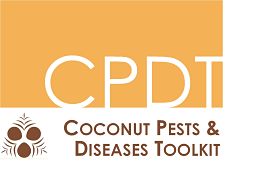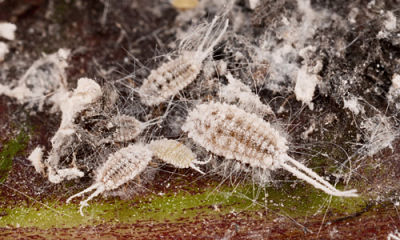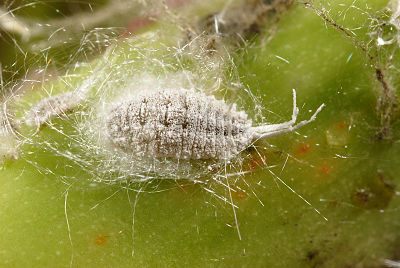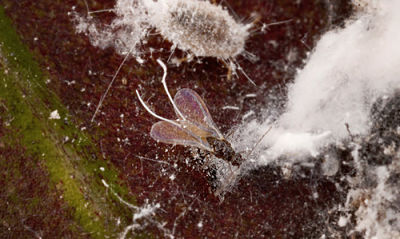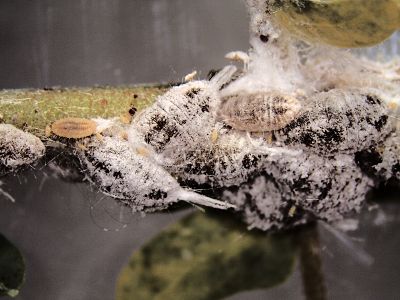Mealybug - striped
Striped mealybug is an invasive pest insect of coconut and other important crops. There is a high risk of outbreak
Common nameStriped mealybug |
Scientific nameFerrisia virgata |
on this page: Life-cycle and identification : Symptoms : Impacts : Distribution : Prevention : Controlling CRB : Information sources and further reading
Life-cycle and identification
Striped mealybugs are sap sucking insects.
Unlike other mealybugs, striped mealybugs produce only small amounts of honeydew. This is because they do not feed on the phloem (the part of the plant that transports sugars and other products from the leaves downwards). For this reason, ants are not usually seen protecting the mealybugs as ants do with other mealybugs.
Striped mealybug colonies may be visible on fruit, the underside of leaves, at the growing points and around the stem connections.
In tropical conditions they are more likely to reproduce rapidly and both adult and nymph life stages will be abundant.
Females mate once in their lifespan of 36-53 days. They give birth to around 64-78 live nymphs, usually in discrete places such as the underside of leaves and where the leaf meets the stem.
NymphsThe first instar is the most mobile stage of a mealybug's life. These young nymphs are called crawlers. Crawlers will move to find feeding sites then move very little from here for the rest of their lives. Nymphs undergo 3 growth stages (instars) over 26 - 57 days, to reach their adult form. Nymphs resemble the adults with a waxy coating, but they are a light yellow colour with long antennae. The antennae have 6 segments in the first and second instar, increasing to then seven segments in the third instar. Male nymps will continue to feed and mature from the second instar, but within a cocoon they make around themselves. The males will become recognisable in the last instar when wing buds are present and the body is dark in colour (like the adult male). The females will start to show the two stripes down their back and the two filaments at the end of their body. AdultsMalesAdult males are dark gray in colour and have a pair of white long waxy filaments and the end of their body. Males have wings. The males also have long antennae (10 segments), simple wings, six well developed legs and hardened body. Males are short lived with a lifespan of 1-3 days. FemalesAdult females are grey-yellow or green-yellow in colour, soft and oval in shape (5mm long). Females have two dark stripes running down their back lengthwise which is covered in a layer of a woolly white wax. Females have two long waxy filaments at the end of their body and many very wispy glass-like threads up to 4.0-4.5 mm long extending from the sides of their bodies. The later stages of a female mealybug's life will be mainly immobile, but they can move to avoid unsuitable conditions. |
Light yellow nymphs with a small pair of waxy filaments, amongst adult females (© Ariane McCorquodale, University of Florida)
Adult female striped mealybug with wispy glass-like threads around the body (© Lyle Buss, University of Florida)
Adult male striped mealybug with a pair of long waxy filaments and wings (© Ariane McCorquodale, University of Florida) |
SymptomsThe feeding of mealybug colonies on the leaves, terminal shoots and fruits can cause wilting, yellowing, and even death, of the palm. Fruit and leaves can also be shed early. There may also be signs of feeding where mealybug colonies are dense. Even though only a little honeydew is produced by striped mealybugs, it can lead to the growth of black sooty moulds on leaves and fruit. The leaves and fruits then have reduced surface area to gain energy from the sun to make food and fuel (photosynthesis) . The palm will become weak and have stunted growth. Fruit will also be stunted. |
Sooty mould growth underneath dense colony of striped mealybugs (© Aubrey Moore, Flickr) |
Impacts
The damage from the striped mealybug feeding and additional production of sooty moulds can heavily reduce the appeal of coconut products on the market.
The striped mealybug is also a vector of the viruses: Cacao swollen shoot virus (CSSV), Cocoa Trinidad virus, Citrus tristeza virus, Badnavirus disease of black pepper and Piper yellow mottle virus.
Introduction in to new areas can have serious impacts, especially when there are no natural predators. Tropical areas are likely to experience large outbreaks with many overlapping generations as they prefer warmer climates.
Distribution
Striped mealybugs have a very wide distribution.
In the Pacific they are reported in Australia, Australian Northern Territory, Queensland, Cook Islands, Fiji, French Polynesia, Kiribati, Marshall Islands, Federated States of Micronesia, Pohnpei, Truk Islands and Yap, New Caledonia, Northern Mariana Islands, Palau, Papua New Guinea, Philippines, Samoa, Solomon Islands, Tonga, Tuvalu, Vanuatu, Wake Island and Wallis and Futuna Islands.
Please check with your local biosecurity / quarantine or SPC for up-to-date distribution information.
Prevention
Most importantly, the International Guidelines for transfer of coconut germplasm should be strictly followed to prevent pests and diseases being moved to new locations.
Due to the striped mealybugs wide variety of host plants and cryptic behaviour, it has many opportunities to spread through the transport of plant materials in national and international trade going unnoticed.
Additional care needs to be taken while importing host plants of striped mealybug to reduce the effects on other important crops.
For general information on preventing pests and diseases of coconut, see the Prevention section.
Controlling striped mealybug
We strongly recommend an integrated pest management (IPM) approach to the control of all insects, where possible. This is a combination of methods (spot application of pesticides, physical controls such as site hygiene, and biological controls) to minimise the use of pesticides and their negative impact on natural enemy populations, so minimising pesticide costs.
Integrated Pest Management (IPM)
The goal of IPM is to keep pest populations to a level below which they cause economic harm. IPM involves using multiple control options together for the economic control of pests (i.e. cultural, natural and chemical).
In an agricultural context the Food and Agriculture Organization defines IPM as "the careful consideration of all available pest control techniques and subsequent integration of appropriate measures that discourage the development of pest populations and keep pesticides and other interventions to levels that are economically justified and reduce or minimize risks to human health and the environment. IPM emphasizes the growth of a healthy crop with the least possible disruption to agro-ecosystems and encourages natural pest control mechanisms".
There are a number of ways to help control mealybug populations.
To ensure the following methods are successful, it is recommended to control ant populations that may be protecting mealybug populations. More information and advice on getting rid of ants can be found on the Pacific Invasive Ant Toolkit.
Cultural
Striped mealybugs can spread rapidly, therefore any infested plant parts should be removed and burnt as soon as an outbreak is detected.
Pruning, and not planting palms close together when possible, is recommended to stop the mealybugs from moving to nearby palms.
When moving infested plant material to remove and burn, keep it covered to reduce the mealybugs from moving.
Natural
Parasitoid wasps, ladybird beetles and other insects have been reported to control striped mealybug. These include;
- Ladybird beetles - Azya luteipes, Cryptolaemus montrouzieri, Neuroptera, Scymnus sp. and Olla v-nigrum
- Parasitoid wasps - Aenasius advena, Leptomastix sp., and the Tetrastichus genus
- Caterpillars - Spalgis epius
- Hoverflyies - Alloagrapta obliqua.
Chemical
Pesticides have been used to control striped mealybugs. These include bendiocarb, diazinon, diflubenzuron, dimethoate, malathion, permethrin, and prothiofos. Prothiofos can be used for spraying with mineral oil and is reported to be more successful than malathion. Many are applied to the soil to be taken up by the roots in to the plant.
However, most sprays need to be deployed on a regular basis due to the overlapping generations of mealybugs. This is time consuming and costly. Some mealybug populations have also shown resistance to pesticides due to the extended applications. Pesticides can also kill many natural predators.
If necessary, treating the mostly wax-less, vulnerable, first instar nymphs is better.
The direct application to the mealybug colonies and plant with insect growth regulators (IGRs), insecticidal soaps, and horticultural oils has been successful.
Information sources and further reading
CABI. 2018. Ferrisia virgata (striped mealybug). [ONLINE]
Infonet Biovision. 2018. Mealybugs. [ONLINE]
McCorquodale, Hodges (UF). 2016. Featured creatures; striped mealybug. [ONLINE]
PIAT. 2018. The Pacific Invasive Ant Toolkit. [ONLINE]
Plant Village. 2018. Coconut; Diseases and Pests, Description, Uses, Propagation. [ONLINE]
Plantwise. 2018. Ferrisia virgata (striped mealybug). [ONLINE]
Scalenet. 2018. Ferrisia virgata (striped mealybug). [ONLINE]
content reviewed by Gillian Watson, August 2018
